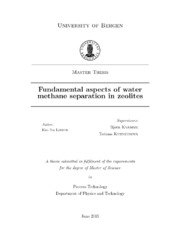Fundamental aspects of water methane separation in zeolites
Master thesis
Permanent lenke
https://hdl.handle.net/1956/7184Utgivelsesdato
2013-06-03Metadata
Vis full innførselSamlinger
Sammendrag
The main objective of this thesis was to use molecular dynamics to investigate the methane interactions with zeolite, specifically the Linde Type A-3A, alongside with an investigation into the use of polynomial path integration for water in zeolite. This thesis is a part of a larger collaboration between the separation group at the University of Bergen and Statoil, with the main goal of explaining the reduced lifetime of zeolites. This thesis continued from the work done by the separation group at the University of Bergen. The then used model was suspect to wrongly describe the methane zeolite interactions. Consequently a new model was tried in order to correctly describe the interactions. The obtained diffusion coefficients for the old and new model, have been compared to reported literature values for a counter-ion free zeolite A. The new model shows an excellent agreement with these values, for a loading of 8 molecules pr alpha-cavity or more. A simulation using the new model in Linde Type A-3A zeolite, shows that potassium blocks all methane motion in the structure. Furthermore, it was observed that potassium motion, at 500 K under the influence of methane, can lead to unblocking of the 8T-window. This leads us to formulate a hypothesis for the reduced lifetime of LTA-3A zeolite. Polynomial path integration was performed for water in zeolite. This was computational difficult, due to the different forces in the multi-specie system. The results revealed that different paths from ideal gas towards real gas gave large differences in the estimated excess Helmholtz energy. Other methods can thus be better suited for this purpose, for example the particle insertion method.
